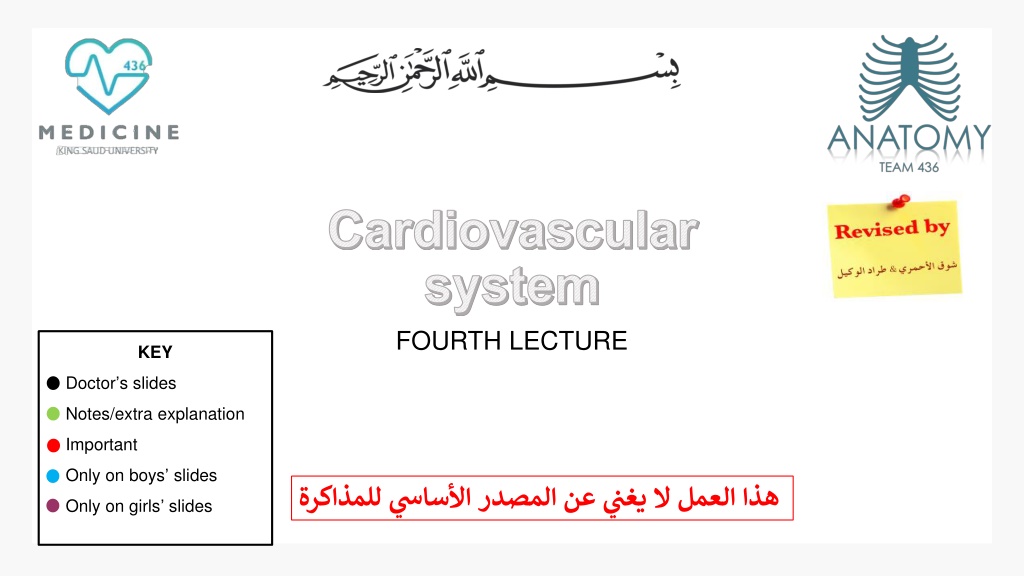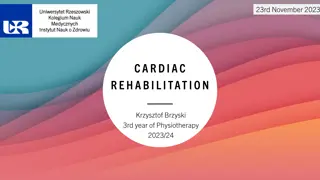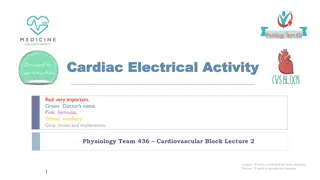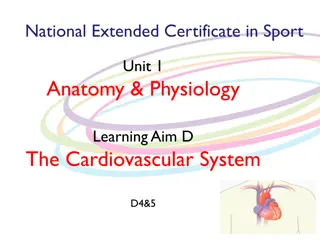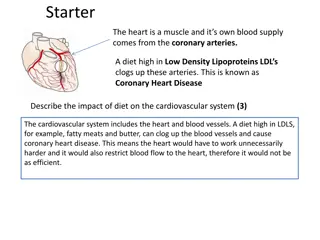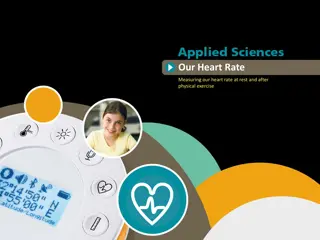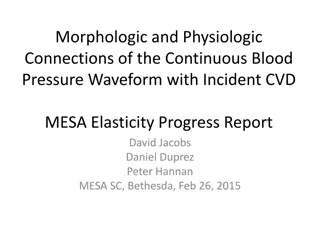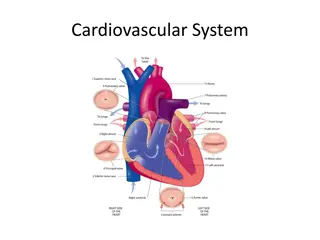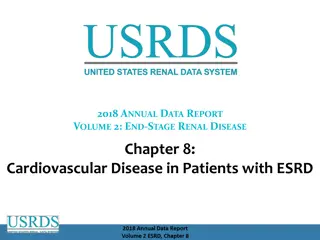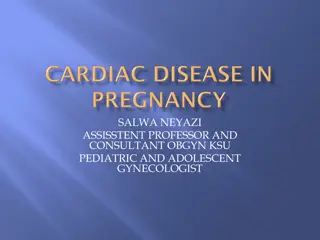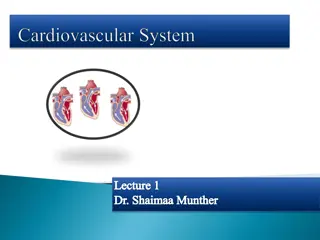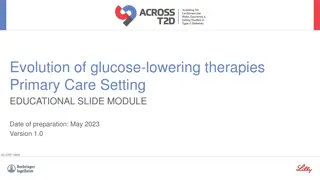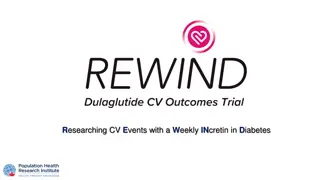Understanding the Cardiovascular System: Heart Structure, Functions, and Components
Explore the intricacies of the cardiovascular system, focusing on the structure and functions of the heart, blood vessels, and key components. Learn about the chambers and valves of the heart, as well as the location and importance of this vital organ within the thoracic cavity.
Download Presentation

Please find below an Image/Link to download the presentation.
The content on the website is provided AS IS for your information and personal use only. It may not be sold, licensed, or shared on other websites without obtaining consent from the author. Download presentation by click this link. If you encounter any issues during the download, it is possible that the publisher has removed the file from their server.
E N D
Presentation Transcript
Cardiovascular system FOURTH LECTURE KEY Doctor s slides Notes/extra explanation Important Only on boys slides Only on girls slides
Objectives: 1. Identify the components of the cardiovascular system. 2. Describe the Heart in regard to (position, chambers and valves). 3. Describe the Blood vessels (Arteries, Veins and Capillaries). 4. Describe the Portal System. 5. Describe the Functional and Anatomical end arteries. 6. Describe the Arteriovenous Anastomosis. 7. Describe the component of the blood and its function. 8. Describe the Sinusoids.
The Cardiovascular System Structure of the heart: Consist of : It is a hollow, cone shaped muscular pump that keeps circulation going on 1. Heart: pumps blood throughout the body . It is the size of the hand s fist of the same person. 2. Blood vessels: a network of tubules. 3. Blood It has : Apex , base surface and borders Structure Functions: Apex Base Surface Borders 1. It is a transportation system which uses the blood as the transport vehicle . Diaphragmati c right 2. It carries oxygen , nutrients, cell wastes, hormones and many other substances vital for body homeostasis. Sternocostal left 3. It provides forces to move the blood around the body . inferior superior
Location of the heart It is located in the thoracic cavity in a place known as the Middle Mediastinum between the two pleural sacs. o Enclosed by a double sac of serous membrane (Pericardium). o 2/3 of the heart lies to the left of median plane. o The outer wall of the heart is made up of three layers: Myocardium (muscle of the heart) Epicardium Endocardium
Chambers of the heart Atria: VENTRICLES: The inferior chambers. They are two (Right & Left). Superior in position. They are two (right & left). They are the receiving chambers. They have thick walls. They have thin walls. They are the discharging chambers (actual pumps). The upper part of each atrium is the Auricle. Their contraction propels blood out of the heart into the circulation. The Right Atrium receives the venous blood coming to the heart. The left ventricle forms the apex of the heart. The Left Atrium receives arterial blood coming from the lungs.
Valves of the heart The heart has FOUR FOUR Two Atrio-Ventricular valves. VALVES: VALVES: The heart has One Aortic Semilunar valve. One Pulmonary Semilunar valve ATRIOVENTRICULAR VALVES: o Location: between atria & ventricles. o Function: they allow the blood to flow in one direction from the atria to the ventricles. o 1-Right AVV (Tricuspid). o 2-Left AVV (Bicuspid/Mitral). SEMILUNAR VALVES (AORTIC & PULMONARY): o Location: between the right and left ventricles and the great arteries leaving the heart (Aorta & Pulmonary trunk). o Function: they allow the flow of blood from the ventricles to arteries.
BLOOD CIRCULATION CARDIO PULMONARY SYSTEMIC BETWEEN THE HEART AND THE LUNGS BETWEEN THE HEART AND THE BODY The right side of the heart (the right atrium & ventricle) receive deoxygenated blood The left side of the heart (left atrium & ventricle) receive the oxygenated blood from the lungs Blood is pumped from the left ventricle to all body tissues through the Aorta and its systemic arteries The blood ultimately terminates in capillaries Blood is pumped to the lungs through the pulmonary Artery Gas exchange takes place in the lungs It returns to the left side of the heart through 4 pulmonary veins Deoxygenated blood circulates from the tissues to the capillaries, venules & veins back to the right atrium of the heart through the systemic veins
CORONARY CIRCULATION For extra explanation visit this link: https://www.youtube.com/watch?v=xSnFf62GDBI o The heart has its own blood vessels that provide the myocardium with the oxygen and nutrients necessary to be able to pump blood to the body. o The left and right coronary arteries branch off from the aorta and provide blood to the left and right sides of the heart. o The coronary sinus is a vein on the posterior side of the heart that returns deoxygenated blood from the myocardium to the vena cava. o Great, middle and small coronary veins drain into coronary sinus. o Coronary sinus drains into right atrium.
The smallest veins are Venules Why do Arteries have thick walls? Veins Thin walled Arteries have much thicker walls than other blood vessels in order to withstand the higher blood pressure that propels oxygenated blood away from the heart Many of them posses valves Blood vessels The smallest arteries are arterioles Arteries Thick walled and do not have valves Connect arterioles and venules Capillaries Help enable the exchange of water , oxygen and nutrients between blood and the tissues
Arteries They transport blood from the heart and distribute it to the various tissues of the body through their branches. Carry oxygenated blood away from the heart. o TWO EXCEPTIONS: The pulmonary arteries. Carries deoxygenated blood from the heart to the lungs. The umbilical arteries. Supplies deoxygenated blood from the fetus to the placenta in the umbilical cord.
Anastomosis End Arteries Anastomosis: the connection between two structures (arteries, veins, or an artery and a vein) End Arteries: They are arteries that are the only supply of oxygenated blood to a tissue. End Arteries Arterial anastomosis: is the joining of terminal branches of the arteries. e.g. Splenic artery Renal artery Anatomic end arteries Functional end arteries Function: It serves as a backup route if one of the branches is cut off(or blocked), allowing the blood to flow through other branches. Vessels whose terminal branches do not anastomose with adjacent arteries. Supplying adjacent areas (Central Artery of Retina) Vessels whose terminal arteries anastomose with adjacent arteries. e.g. abdominal anastomosis (see picture) intestinal arteries Note: the anastomosis is insufficient to keep the tissue alive if one of the arteries becomes blocked. Arterial anastomosis
Veins Deep Veins (Venae Comitantes) o They transport blood back to the heart. o The smaller venules (Tributries) unite to form larger veins which commonly join with one another to form Venous Plexuses. o Carry deoxygenated blood towards the heart in all situations except two: Pulmonary vein: carries the oxygenated blood from the lungs back to the heart (left atrium) Umbilical vein: Carries the oxygenated blood from the placenta towards the fetus Note: Veins do not branch they only unite. They are two veins that accompany medium sized deep arteries. They are found in close to arteries so that the pulsations of the artery aid venous return. Venae comitantes are usually found with smaller arteries, especially those in the limbs. Larger arteries do not have venae comitantes. They usually have a single, similarly sized vein.
CAPILLARIES CAPILLARIES o Microscopic vessels in the form of a network. Function: o They connect the Arterioles to the Venules. o They help to enable the exchange of water, oxygen and many. other nutrients between blood and the tissues.
ARTERIOVENOUS ANASTOMOSIS Direct connections between the arteries and veins without the intervention of capillaries. Found in tips of the fingers and toes.
Portal circulation Portal circulation Portal Venous System occurs when a capillary bed pools into another capillarybed through veins, without first going through theheart. It is a system of vessels interposed between Two Capillary Beds. Takes place in the liver and some endocrine glands (pituitary gland). The purpose of hepatic portal circulation is to deliver blood from some parts of the gastrointestinal tract to the liver. In other words, blood is drained from the digestive organs (and the spleen, gall bladder, and pancreas) and the blood is then delivered to the liver.
Portal C Portal Circulation irculation Gastro intestinal Tract Sinusoids (first capillary bed) Portal vein Liver Sinusoids are: Thin walled blood vessels like capillaries. Wider with irregular cross diameter. Found in : liver, spleen, bone marrow, pituitary gland . Veins leaving the gastrointestinal tract do not go direct to the heart. They pass to the Portal Vein. This vein enters the liver and breaks up again into veins of diminishing size which ultimately join capillary like vessels (Sinusoids). Venous blood enter 2ndcapillary bed then to smaller veins that leave the liver through the hepatic vein. The sinusoids will get rid of the food by giving it to the liver cells which are surrounded by them . Why doesn t the blood go straight to the heart? Because it contains food with Venus blood (food can't go to the heart).
BLOOD o Blood is the actual carrier of the oxygen and nutrients into arteries. o Blood is made mostly of plasma, which is a yellowish liquid that is 90% water. o Plasma contains also salts, glucose and other substances. o Most important, plasma contains proteins that carry important nutrients to the body s cells and strengthen the body s immune system. o Blood has main 3 types of blood cells that circulate with the plasma. Blood Formed elements Plasma Other solutes (Example: Electrolytes) Plasma protein Red blood cells White blood cells Water Platelets
TYPES OF BLOOD CELLS PLATELETS: Helping the blood to clot. Clotting stops the blood from flowing out of the body when a vein or artery is broken. Platelets are also called thrombocytes. RED BLOOD CELLS Carry oxygen. A healthy adult has about 35 trillion of them. Red blood cells are also called erythrocytes. WHITE BLOOD CELLS These cells, which come in many shapes and sizes, are vital to the immune system against infections. When the body is fighting off infection, they increase. White blood cells are also called leukocytes.
Cardiovascular Cardiovascular Diseases Diseases HEMORRHAGIC STROKE Occurs when a blood vessel within the brain bursts. The most likely cause is uncontrolled hypertension. HEART FAILURE It means the heart isn't pumping blood as well as it should. The heart keeps working, but the body's need for blood and oxygen isn't being met. ARRHYTHMIA This is an abnormal rhythm of the heart. The heart can beat too slow, too fast or irregularly. HEART VALVE PROBLEMS When heart valves don't open enough to allow the blood to flow through as it should. HEART ATTACK Occurs when blood flow to a part of the heart is blocked by a blood clot. If this clot cuts off the blood flow completely, the part of the heart muscle supplied by that artery begins to die. Most people survive their first heart attack and return to their normal lives to enjoy many more years of productive activity. ISCHEMIC STROKE Happens when a blood vessel that feeds the brain gets blocked, usually from a blood clot. When the blood supply to a part of the brain is shut off, brain cells will die.
Summary Summary o The cardiovascular system is a transporting system. o It is composed of the heart and blood vessels. o The heart is cone shaped, covered by pericardium and composed of four chambers. o The blood vessels are the arteries, veins and capillaries. o Arteries transport the blood from the heart. o The terminal branches of the arteries can anastomose with each other freely or be anatomic or functional end arteries. o Veins transport blood back to the heart. o Capillaries connect the arteries to the veins. o Sinusoids are special types of capillaries. o The portal system is composed of two sets of capillaries. o The veins from the GIT go first to the liver through the portal vein. o Blood is the actual carrier of the oxygen and nutrients into arteries.
Test what youve studied with an online quiz: https://www.onlineexambuilder.com/cardiovascular-system/exam-37019
Team Members Jawaher Abanumy (Leader) Dania Alkelabi Heba Alnasser Deena Alnowiser Jawaher Alkhayyal Rana Barasain Wejdan Alzaid Shouq Albogami Lara AlSaleem Ghadah Almazrou Ameera Niazi Lama Alfawzan Nawaf AlKhudairy (Leader) Mohammed Ghandour Khalid Aleedan Abdullah Jammah Abdulmalik Alhadlaq Majed Al Zain Rakan Bahammam Mosaed Alnowaiser Mohammed Alyousef Mohammed Nasr : anatomyteam436@gmail.com
